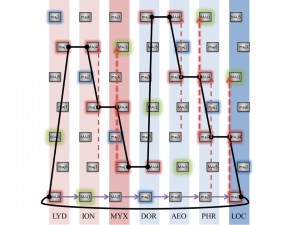the diagram above is known as a 5×3 diagram because it has movements of fifths along the X axis and movements of thirds along the y-axis. Alternatively, this is known as a key core diagram since it shows a key configuration horizontally.
the importance of this diagram lay in the fact that it neatly summarizes the dynamic content of the heptatonic major scale. By aligning our movements in fits horizontally, we arrange our scales or our modes in the most harmonious way possible. In fact, the tritone has been relegated to be outside the normal sequence such that you can traverse from Lydian to Locrian and back again and never have to explicitly travel a tritone. Further, by putting a court structure vertically we have a convenient way of mapping out the tritone’s that come from John space and the flat nines which come from step space. And by mapping these two dissonances in our key core diagram, we obtain a visual which clearly indicates how the Ionian and Aeolian modes are the most relaxed modes by having the tritone furthest removed from the base note and thus merit the designation of tonics. While on the other hand, Locrian and mixolydian have their tritone’s closest to the base note and are thus the most tense cords and thus properly receive the dominance designation. Finally, we notice that the Dorian and the Lydian both have a tritone that spans a larger than an octave, something that we call an ambiguous tritone, and thus both of these are in the subdominant designation.
A point of contention is what to consider for Phrygian and given that it is not dominant but it can take subdominant or tonic characteristics, we call it a conditional tonic or a conditional dominant
KC Space


